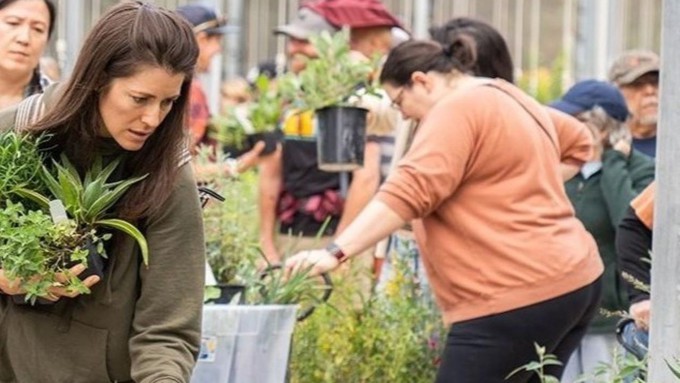
UC Davis Arboretum celebrates 50 years of fall plant sales

UC Davis Arboretum plant sales always draw crowds. Join the Friends of the Arboretum for first crack at this fall's sales. UC Davis Arboretum
Where can you find hundreds of varieties of water-wise, drought-tolerant plants that are perfect for the greater Sacramento area? At the UC Davis Arboretum’s plant sales, of course.
It’s (almost) sale time again at the UC Davis Arboretum Teaching Nursery! And this autumn is special as the Arboretum celebrates 50 years of plant sales.
Kicking off its fall schedule of Saturday sales, the nursery will host a private sale for Friends of the Arboretum from 9 a.m. to 1 p.m. Oct. 5. Not yet a Friend? Join at the gate or online and receive 10% off your purchases plus a free gift.
Following the Members Only Sale, the nursery will host a Split Sale on Oct 26. Friends get first crack from 9 to 10 a.m., then the sale opens to the general public from 10 a.m. to 1 p.m.
Wrapping up the fall schedule is a Clearance Sale on Nov 16; it’s open to everyone from 9 a.m. to 1 p.m.
“Shop the one-acre Arboretum Teaching Nursery to find an incredible selection of attractive, low-water plants perfect for our region,” say the organizers. “By choosing to shop with us, not only will you bring home beautiful plants that help support a sustainable environment, your purchases play a vital role in supporting the growth and care of our gardens, student environmental leadership opportunities, and free public programs.
“Discover the joys of gardening with plants that help heal our environment while nurturing our community!”
Admission to the sale is free. Parking is available for a charge in the nearby UCD parking lots.
In addition to customers, the nursery also needs volunteers to assist shoppers, staff the checkout stations, count plants and more. Sign up now to participate in any of the three fall sales.
What’s for sale? The nursery boasts an extensive inventory, which is now available online for browsing. It’s must reading before you go.
The Arboretum Teaching Nursery is located on Garrod Drive near the Veterinary Small Animal Hospital on the UC Davis Campus.
For directions and links to volunteer and the inventory list: https://arboretum.ucdavis.edu/plant-sales.
Comments
0 comments have been posted.Sacramento Digs Gardening to your inbox.
Food in My Back Yard Series
April 22: Should you stock up on fertilizer? (Yes!)
April 15: Grow culinary herbs in containers
April 8: When to plant summer vegetables
April 1: Don't be fooled by these garden myths
March 25: Fertilizer tips: How to 'feed' your vegetables for healthy growth
March 18: Time to give vegetable seedlings some more space
March 11: Ways to win the fight against weeds
March 4: Potatoes from the garden
Feb. 25: Plant a fruit tree now -- for later
Feb. 18: How to squeeze more food into less space
Feb. 11: When to plant? Consider staggering your transplants
Feb. 4: Starting in seed starting
Sites We Like
Garden Checklist for week of April 27
Once the clouds clear, get to work. Spring growth is in high gear.
* Set out tomato, pepper and eggplant transplants.
* From seed, plant beans, beets, cantaloupes, carrots, corn, cucumbers, melons, pumpkins, radishes and squash. Plant onion sets.
* In the flower garden, plant seeds for asters, cosmos, celosia, marigolds, salvia, sunflowers and zinnias. Transplant petunias, zinnias, geraniums and other summer bloomers.
* Plant perennials and dahlia tubers for summer bloom. Late April is about the last chance to plant summer bulbs, such as gladiolus and tuberous begonias.
* Transplant lettuce and cabbage seedlings.
* Weed, weed, weed! Don’t let unwanted plants go to seed.
* April is the last chance to plant citrus trees such as dwarf orange, lemon and kumquat. These trees also look good in landscaping and provide fresh fruit in winter.
* Feed citrus trees with a low dose of balanced fertilizer (such as 10-10-10) during bloom to help set fruit. Keep an eye out for ants.
* Apply slow-release fertilizer to the lawn.
* Thoroughly clean debris from the bottom of outdoor ponds or fountains.
* Start thinning fruit that's formed on apple and stone fruit trees -- you'll get larger fruit at harvest (and avoid limb breakage) if some is thinned now. The UC recommendation is to thin fruit when it is about 3/4 of an inch in diameter. Peaches and nectarines should be thinned to about 6 inches apart; smaller fruit such as plums and pluots can be about 4 inches apart. Apricots can be left at 3 inches apart. Apples and pears should be thinned to one fruit per cluster of flowers, 6 to 8 inches apart.
* Azaleas and camellias looking a little yellow? If leaves are turning yellow between the veins, give them a boost with chelated iron.
* Trim dead flowers but not leaves from spring-flowering bulbs such as daffodils and tulips. Those leaves gather energy to create next year's flowers. Also, give the bulbs a fertilizer boost after bloom.
* Pinch chrysanthemums back to 12 inches for fall flowers. Cut old stems to the ground.
* Mulch around plants to conserve moisture and control weeds.